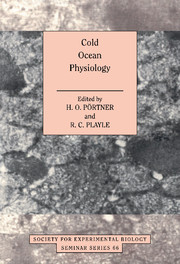Book contents
- Frontmatter
- Contents
- List of contributors
- Preface
- PART I General concepts
- PART II Compensatory adaptations in cold ocean environments
- Adaptation to cold and depth: contrasts between polar and deep-sea animals
- Temperature and growth rates as modulators of the metabolic capacities of fish muscle
- Energetic aspects of cold adaptation: critical temperatures in metabolic, ionic and acid-base regulation?
- Physiological and evolutionary aspects of myoglobin expression in the haemoglobinless Antarctic icefishes
- Oxygen transport systems in extreme environments: multiplicity and structure-function relationship in haemoglobins of Antarctic fish
- Membrane lipid and protein adaptations in Antarctic fish
- Kinetics of enzymes in cold-stenothermal invertebrates
- Effects of low temperature on prooxidant processes and antioxidant defence systems in marine organisms
- PART III Exploitative adaptations
- PART IV Integrative approaches
- PART V Applied approaches
- Index
Temperature and growth rates as modulators of the metabolic capacities of fish muscle
Published online by Cambridge University Press: 13 March 2010
- Frontmatter
- Contents
- List of contributors
- Preface
- PART I General concepts
- PART II Compensatory adaptations in cold ocean environments
- Adaptation to cold and depth: contrasts between polar and deep-sea animals
- Temperature and growth rates as modulators of the metabolic capacities of fish muscle
- Energetic aspects of cold adaptation: critical temperatures in metabolic, ionic and acid-base regulation?
- Physiological and evolutionary aspects of myoglobin expression in the haemoglobinless Antarctic icefishes
- Oxygen transport systems in extreme environments: multiplicity and structure-function relationship in haemoglobins of Antarctic fish
- Membrane lipid and protein adaptations in Antarctic fish
- Kinetics of enzymes in cold-stenothermal invertebrates
- Effects of low temperature on prooxidant processes and antioxidant defence systems in marine organisms
- PART III Exploitative adaptations
- PART IV Integrative approaches
- PART V Applied approaches
- Index
Summary
Much as the external morphology of fish is indicative of their swimming style, the metabolic capacities of their muscle reflect this locomotor style. The overall capacity for ATP generation, in both the glycolytic and aerobic pathways is much higher in the muscle of the fast and continuously swimming tunas than in intermittently active flatfish or the slow-moving cod. Abyssal fish take this pattern to an extreme in maintaining low levels of protein and enzymes in their musculature (Siebenaller & Yancey, 1984). On the other hand, for any given fish, muscle metabolic capacities change with the abiotic and biotic factors, principally temperature, food availability and reproductive activity, to which fish are exposed. In this chapter, the impact of temperature, food availability and growth rates upon muscle metabolic capacities in fish will be examined and potential interactions among these factors addressed.
Temperature is a major factor determining physiological performance of fishes. For most fish, thermal changes in the habitat modify body temperature due to rapid thermal equilibration across the gills. Thermal fluctuations in any living system affect reaction rates as well as the non-covalent interactions which stabilise biochemical structures. In response to either short- or long-term thermal changes, individual organisms often adjust their physiological rates as well as their exact biochemical composition. Therefore, temperature effects on muscle metabolic capacities must be considered both on the level of long-term adjustments which may imply genetic modifications and on the level of short-term phenotypic adjustments. Muscle metabolic capacities may also be modified by indirect thermal effects upon food availability and the ensuing impact upon growth and energetic status.
- Type
- Chapter
- Information
- Cold Ocean Physiology , pp. 58 - 87Publisher: Cambridge University PressPrint publication year: 1998
- 20
- Cited by

